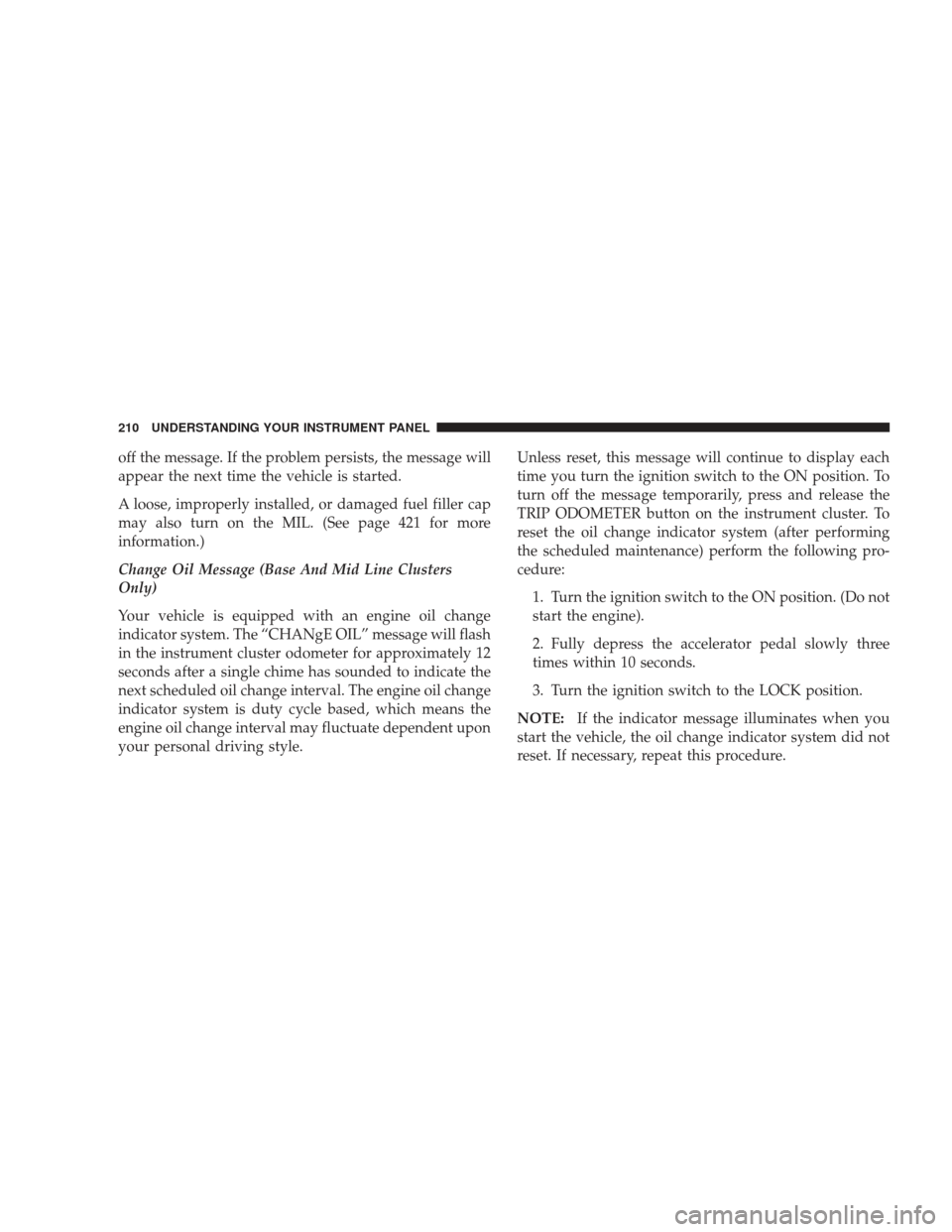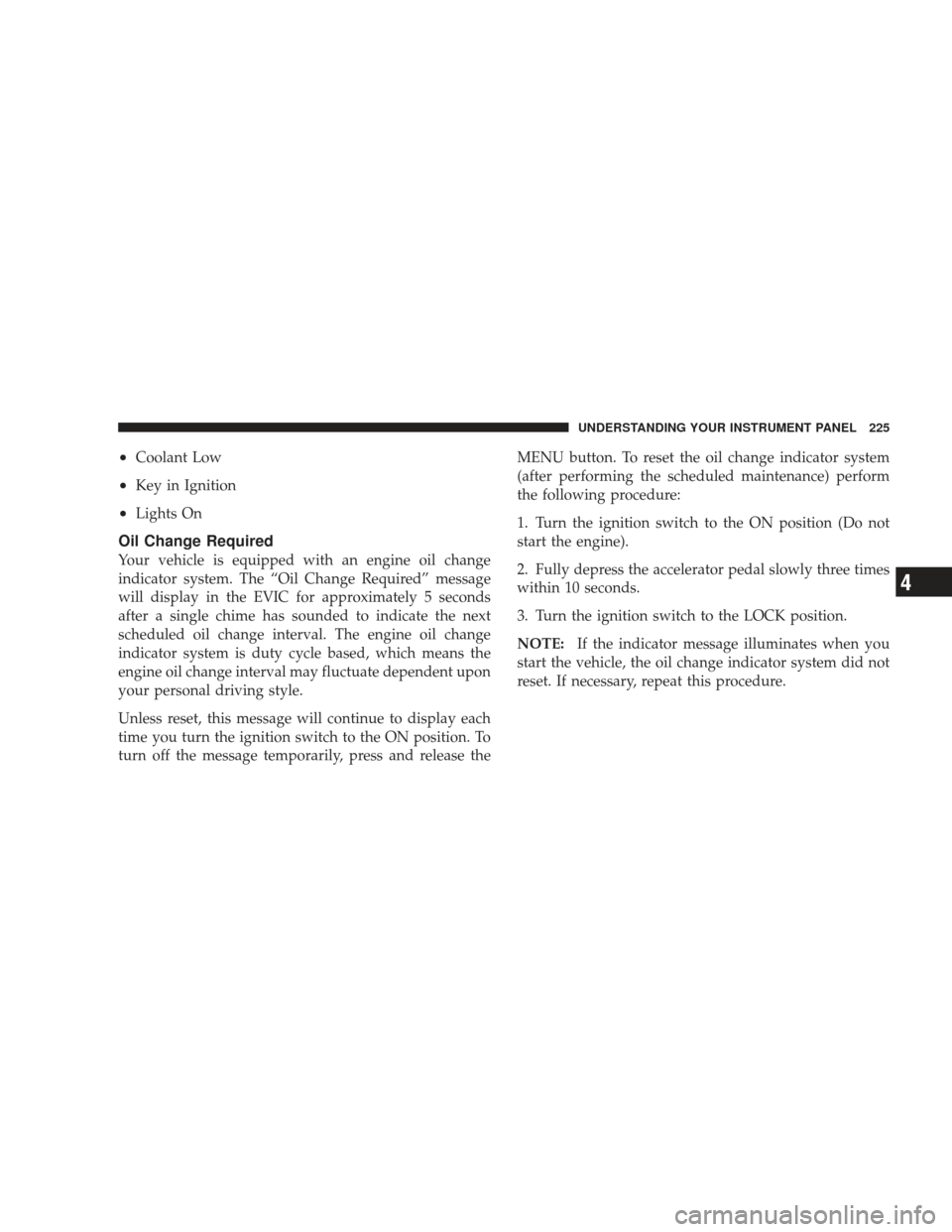Page 212 of 523

off the message. If the problem persists, the message will
appear the next time the vehicle is started.
A loose, improperly installed, or damaged fuel filler cap
may also turn on the MIL. (See page 421 for more
information.)
Change Oil Message (Base And Mid Line Clusters
Only)
Your vehicle is equipped with an engine oil change
indicator system. The “CHANgE OIL” message will flash
in the instrument cluster odometer for approximately 12
seconds after a single chime has sounded to indicate the
next scheduled oil change interval. The engine oil change
indicator system is duty cycle based, which means the
engine oil change interval may fluctuate dependent upon
your personal driving style.Unless reset, this message will continue to display each
time you turn the ignition switch to the ON position. To
turn off the message temporarily, press and release the
TRIP ODOMETER button on the instrument cluster. To
reset the oil change indicator system (after performing
the scheduled maintenance) perform the following pro-
cedure:
1. Turn the ignition switch to the ON position. (Do not
start the engine).
2. Fully depress the accelerator pedal slowly three
times within 10 seconds.
3. Turn the ignition switch to the LOCK position.
NOTE: If the indicator message illuminates when you
start the vehicle, the oil change indicator system did not
reset. If necessary, repeat this procedure.
210 UNDERSTANDING YOUR INSTRUMENT PANEL
Page 213 of 523

16. Electronic Throttle Control (ETC) Warning Light —
If EquippedThis light will turn on briefly as a bulb check
when the ignition switch is turned ON. This
light will also turn on while the engine is
running if there is a problem with the Elec-
tronic Throttle Control (ETC) system.
If the light turns on while the engine is running, safely
bring the vehicle to a complete stop as soon as possible,
place the shift lever in PARK, and cycle the ignition key.
The light should turn off. If the light remains lit with the
engine running, your vehicle will usually be drivable.
However, see your authorized dealer for service as soon
as possible.
If the light is flashing when the engine is running,
immediate service is required. In this case, you may
experience reduced performance, an elevated/rough idle
or engine stall, and your vehicle may require towing. Also, have the system checked by an authorized dealer if
the light does not turn on during starting.
17. Oil Pressure Warning Light
This light shows low engine oil pressure. The light
will turn on and remain on when the ignition
switch is turned from the LOCK or ACC position to the
ON position. The light will turn off after the engine is
started.
If the light does not turn on during starting, have the
system checked by an authorized dealer.
If the light turns on and remains on while driving, safely
bring the vehicle to a stop and shut off the engine. DO
NOT OPERATE THE VEHICLE UNTIL THE CAUSE IS
CORRECTED. This light does not show the quantity of
oil in the engine. The engine oil level must be checked
using the proper procedure. (See page 424 for more
information.)
UNDERSTANDING YOUR INSTRUMENT PANEL 211
4
Page 226 of 523

•Channel # Transmit. Refer to “Garage Door Opener” in
Section 2.
•Channel # Training. Refer to “Garage Door Opener” in
Section 2.
•Channel # Trained. Refer to “Garage Door Opener” in
Section 2.
•Clearing Channels. Refer to “Garage Door Opener” in
Section 2.
•Channels Cleared. Refer to “Garage Door Opener” in
Section 2.
•Did Not Train. Refer to “Garage Door Opener” in
Section 2.
•Left Front Low Pressure (with a single chime). Refer to
information on “Tire Pressure” and “Tire Pressure
Monitor” in Section 5.
•Left Rear Low Pressure (with a single chime). Refer to
information on “Tire Pressure” and “Tire Pressure
Monitor” in Section 5.
•Right Front Low Pressure (with a single chime). Refer
to information on “Tire Pressure” and “Tire Pressure
Monitor” in Section 5.
•Right Rear Low Pressure (with a single chime). Refer
to information on “Tire Pressure” and “Tire Pressure
Monitor” in Section 5.
•Check TPM System (with a single chime). Refer to
information on “Tire Pressure Monitor” in Section 5.
•Low Fuel
•Cal
•Oil Change Required (with a single chime)
•Low Washer Fluid
224 UNDERSTANDING YOUR INSTRUMENT PANEL
Page 227 of 523

•Coolant Low
•Key in Ignition
•Lights On
Oil Change Required
Your vehicle is equipped with an engine oil change
indicator system. The “Oil Change Required” message
will display in the EVIC for approximately 5 seconds
after a single chime has sounded to indicate the next
scheduled oil change interval. The engine oil change
indicator system is duty cycle based, which means the
engine oil change interval may fluctuate dependent upon
your personal driving style.
Unless reset, this message will continue to display each
time you turn the ignition switch to the ON position. To
turn off the message temporarily, press and release theMENU button. To reset the oil change indicator system
(after performing the scheduled maintenance) perform
the following procedure:
1. Turn the ignition switch to the ON position (Do not
start the engine).
2. Fully depress the accelerator pedal slowly three times
within 10 seconds.
3. Turn the ignition switch to the LOCK position.
NOTE:
If the indicator message illuminates when you
start the vehicle, the oil change indicator system did not
reset. If necessary, repeat this procedure.
UNDERSTANDING YOUR INSTRUMENT PANEL 225
4
Page 307 of 523

�Tire Pressure Monitor System (TPMS) —
If Equipped ...........................355
▫ Base System — If Equipped ..............358
▫ Premium System — If Equipped ..........360
▫ General Information ...................363
� Flexible Fuel— 2.7L Engines Only
(Except California Emission States) ..........364
▫ E-85 General Information ................364
▫ Ethanol Fuel (E-85) ....................365
▫ Fuel Requirements ....................365
▫ Selection Of Engine Oil For Flexible Fuel
Vehicles (E-85) And Gasoline Vehicles .......366
▫ Starting ............................367
▫ Cruising Range .......................367 ▫
Replacement Parts .....................367
▫ Maintenance .........................367
� Fuel Requirements ......................368
▫ 2.4L And 2.7L Engines ..................368
▫ 3.5L Engine .........................368
▫ Reformulated Gasoline .................369
▫ Gasoline/Oxygenate Blends ..............369
▫ MMT In Gasoline .....................370
▫ Materials Added To Fuel ................371
▫ Fuel System Cautions ..................371
▫ Carbon Monoxide Warnings ..............372
� Adding Fuel ..........................372
▫ Fuel Filler Cap (Gas Cap) ...............372
STARTING AND OPERATING 305
5
Page 324 of 523

CAUTION!
•Always check the depth of the standing water
before driving through it. Never drive through
standing water that is deeper than the bottom of
the tire rims mounted on the vehicle.
•Determine the condition of the road or the path
that is under water, and if there are any obstacles
in the way, before driving through the standing
water.
•Do not exceed 5 mph (8 km/h) when driving
through standing water. This will minimize wave
effects.
CAUTION!
•Driving through standing water may cause dam-
age to your vehicle’s drivetrain components. Al-
ways inspect your vehicle’s fluids (i.e., engine oil,
transmission, axle, etc.) for signs of contamination
(i.e., fluid that is milky or foamy in appearance)
after driving through standing water. Do not con-
tinue to operate the vehicle if any fluid appears
contaminated, as this may result in further dam-
age. Such damage is not covered by the New
Vehicle Limited Warranty.
•Getting water inside your vehicle’s engine can
cause it to lock up and stall out, and cause serious
internal damage to the engine. Such damage is not
covered by the New Vehicle Limited Warranty.
322 STARTING AND OPERATING
Page 354 of 523

These indicators are molded into the bottom of the tread
grooves. They will appear as bands when the tread depth
becomes 1/16 in (2 mm). When the tread is worn to the
tread wear indicators, the tire should be replaced.
Many states have laws requiring tire replacement at this
point.
Life of Tire
The service life of a tire is dependent upon varying
factors including, but not limited to:
•Driving style
•Tire pressure
•Distance driven
WARNING!
Tires and the spare tire should be replaced after six
years, regardless of the remaining tread. Failure to
follow this warning can result in sudden tire failure.
You could lose control and have an accident resulting
in serious injury or death.
Keep dismounted tires in a cool, dry place with as little
exposure to light as possible. Protect tires from contact
with oil, grease, and gasoline.
Replacement Tires
The tires on your new vehicle provide a balance of many
characteristics. They should be inspected regularly for
wear and correct cold tire inflation pressure. The manu-
facturer strongly recommends that you use tires equiva-
lent to the originals in size, quality and performance
when replacement is needed. (Refer to the paragraph on
352 STARTING AND OPERATING
Page 368 of 523

For best results, a refueling pattern that avoids alternat-
ing between E-85 and unleaded gasoline is recom-
mended.
When you do switch fuel types it is recommended that:
•you do not add less than 5 gal (19 L) when refueling
•you drive the vehicle immediately after refueling for at
least 5 miles (8 km)
Observing these precautions will avoid possible hard
starting and/or significant deterioration in driveability
during warm up.
NOTE: Use seasonally adjusted E-85 fuel (ASTM
D5798). With non-seasonally adjusted E-85 fuel you may
experience hard starting and rough idle following start
up even if the above recommendations are followed,
especially when the ambient temperature is below 32°F
(0°C).
Engine Block Heater (if equipped)
Block heater usage is beneficial for E-85 startability when
the ambient temperature is less than 32°F (0°C).
SELECTION OF ENGINE OIL FOR FLEXIBLE
FUEL VEHICLES (E-85) AND GASOLINE
VEHICLES
FFV vehicles operated on E–85 require specially formu-
lated engine oils. These special requirements are included
in Mopar� engine oils, and in equivalent oils meeting
Chrysler Specification MS-6395. The manufacturer only
recommends engine oils that are API Certified and meet
the requirements of Material Standard MS-6395. MS-6395
contains additional requirements, developed during ex-
tensive fleet testing, to provide additional protection to
the manufacturer’s engines. Use Mopar� or an equivalent
oil meeting the specification MS-6395.
NOTE: Your engine oil filler cap also describes the
correct engine oil to use.
366 STARTING AND OPERATING